Identifying Environmental Determinants Relevant to Health and Wellbeing in Remote Australian Indigenous Communities: A Scoping Review of Grey Literature
Abstract
1. Introduction
- identify and characterize the key characteristics of publicly available planning, policy, and reporting documents relevant to remote Indigenous communities in the NT;
- classify community-level built and socio-political environmental indicators using an Indigenous indicator classification system (IICS).
2. Study Context
3. Materials and Methods
- Indigenous Australian OR Aboriginal OR Torres Strait Islander AND;
- community AND;
- environment AND;
- plan OR policy OR report AND;
- Northern Territory OR NT.
- The organization is responsible for the delivery of community health and environmental programs to Indigenous people specific to one or more remote communities in the NT;
- the organization publishes community-level policy, reporting, evaluation, strategic planning, or local planning documents with a focus relevant to health and wellbeing, including preventable infectious disease and chronic disease; and
- the organization is a member of a peak body in the NT.
4. Results
5. Discussion
6. Conclusions
Supplementary Materials
Author Contributions
Funding
Institutional Review Board Statement
Informed Consent Statement
Acknowledgments
Conflicts of Interest
References
- Rose, G. Sick individuals and sick populations. Int. J. Epidemiol. 2001, 30, 427–432. [Google Scholar] [CrossRef] [PubMed]
- Prüss-Üstün, A.; Wolf, J.; Corvalán, C.; Bos, R.; Neira, M. Preventing Disease through Healthy Environments: A Global Assessment of the Burden of Disease from Environmental Risks; World Health Organization: Geneva, Switzerland, 2016. [Google Scholar]
- Daniel, M.; Lekkas, P.; Cargo, M. Environments and Cardiometabolic Diseases in Aboriginal Populations. Heart Lung Circ. 2010, 19, 306–315. [Google Scholar] [CrossRef] [PubMed]
- Daniel, M.; Lekkas, P.; Cargo, M.; Stankov, I.; Brown, A. Environmental Risk Conditions and Pathways to Cardiometabolic Diseases in Indigenous Populations. Annu. Rev. Public Health 2011, 32, 327–347. [Google Scholar] [CrossRef] [PubMed]
- United Nations Development Programme. Human Development Report 2015: Work for Human Development; UNDP: New York, NY, USA, 2015; ISBN 978-92-1-057615-4. [Google Scholar]
- Anderson, I.; Robson, B.; Connolly, M.; Al-Yaman, F.; Bjertness, E.; King, A.; Tynan, M.; Madden, R.; Bang, A.; Coimbra, C.E.A.; et al. Indigenous and tribal peoples’ health (The Lancet–Lowitja Institute Global Collaboration): A population study. Lancet 2016, 388, 131–157. [Google Scholar] [CrossRef]
- Gracey, M.; King, M. Indigenous health part 1: Determinants and disease patterns. Lancet 2009, 374, 65–75. [Google Scholar] [CrossRef]
- AIHW. Mortality Inequalities in Australia 2009–2011; Bulletin No. 124; Australian Institute of Health and Welfare: Canberra, Australia, 2014.
- Zhao, Y.; Dempsey, K. Causes of inequality in life expectancy between Indigenous and non-Indigenous people in the Northern Territory, 1981–2000: A decomposition analysis. Med. J. Aust. 2006, 184, 490–494. [Google Scholar] [CrossRef]
- Zhao, Y.; You, J.; Wright, J.; Guthridge, S.L.; Lee, A.H. Health inequity in the Northern Territory, Australia. Int. J. Equity Health 2013, 12, 79. [Google Scholar] [CrossRef] [PubMed]
- Gibney, K.B.; Cheng, A.C.; Hall, R.; Leder, K. Sociodemographic and geographical inequalities in notifiable infectious diseases in Australia: A retrospective analysis of 21 years of national disease surveillance data. Lancet Infect. Dis. 2017, 17, 86–97. [Google Scholar] [CrossRef]
- AHMAC. Aboriginal and Torres Strait Islander Health Performance Framework 2014 Report; Australian Health Ministers’ Advisory Council: Canberra, Australia, 2015. [Google Scholar]
- AIHW. Australian Burden of Disease Study: Impact and Causes of Illness and Death in Aboriginal and Torres Strait Islander People 2011; Australian Burden of Disease Study Series No. 6. Cat. No. BOD 7; Australian Institute of Health and Welfare: Canberra, Australia, 2016.
- Vos, T.; Barker, B.; Begg, S.; Stanley, L.; Lopez, A.D. Burden of disease and injury in Aboriginal and Torres Strait Islander Peoples: The Indigenous health gap. Int. J. Epidemiol. 2008, 38, 470–477. [Google Scholar] [CrossRef]
- Marmot, M.; Friel, S.; Bell, R.; Houweling, T.A.J.; Taylor, S.; Commission on Social Determinants of Health. Closing the gap in a generation: Health equity through action on the social determinants of health. Lancet 2008, 372, 1661–1669. [Google Scholar] [CrossRef]
- Raghavan, A.; Demircioglu, M.A.; Taeihagh, A.; Health, P. Public Health Innovation through Cloud Adoption: A Comparative Analysis of Drivers and Barriers in Japan, South Korea, and Singapore. Int. J. Environ. Res. Public Health 2021, 18, 334. [Google Scholar] [CrossRef] [PubMed]
- Carson, B.; Dunbar, T.; Chenhall, R.D.; Bailie, R. Social Determinants of Indigenous Health; Allen & Unwin: Crow’s Nest, Sydney, Australia, 2007. [Google Scholar]
- Øversveen, E.; Eikemo, T.A. Reducing Social Inequalities in Health: Moving from the ‘Causes of the Causes’ to the ‘Causes of the Structures’; Sage Publications: London, UK, 2018. [Google Scholar]
- King, M.; Smith, A.; Gracey, M. Indigenous health part 2: The underlying causes of the health gap. Lancet 2009, 374, 76–85. [Google Scholar] [CrossRef]
- Marmot, M. Social determinants and the health of Indigenous Australians. Med. J. Aust. 2011, 194, 512–513. [Google Scholar] [CrossRef] [PubMed]
- Bond, C.J.; Singh, D. More than a refresh required for closing the gap of Indigenous health inequality. Med. J. Aust. 2020, 212, 198–199.e1. [Google Scholar] [CrossRef]
- AIHW. Towards National Indicators of Safety and Quality in Health Care; Australian Institute of Health and Welfare: Canberra, Australia, 2009. [Google Scholar]
- Josif, D. Universal Core Service Framework, Performance Indicators and Workforce Implications; Department of Health: Darwin, Australia, 2011.
- Productivity Commission. Indigenous Evaluation Strategy (Draft); Australian Government: Canberra, Australia, 2020.
- Harwood, S.; Wensing, E.; Ensign, P.C. Place-Based Planning in Remote Regions: Cape York Peninsula, Australia and Nunavut, Canada: Remote Human Settlements in Developed Nations; Edward Elgar Publishing: Cheltenham, UK, 2016; p. 124. [Google Scholar]
- Lane, M.B.; Corbett, T. The Tyranny of localism: Indigenous participation in community-based environmental management. J. Environ. Policy Plan. 2005, 7, 141–159. [Google Scholar] [CrossRef]
- Colquhoun, H.L.; Levac, D.; O’Brien, K.K.; Straus, S.; Tricco, A.C.; Perrier, L.; Kastner, M.; Moher, D. Scoping reviews: Time for clarity in definition, methods, and reporting. J. Clin. Epidemiol. 2014, 67, 1291–1294. [Google Scholar] [CrossRef] [PubMed]
- Arksey, H.; O’Malley, L. Scoping studies: Towards a methodological framework. Int. J. Soc. Res. Methodol. 2005, 8, 19–32. [Google Scholar] [CrossRef]
- Peters, M.D.; Godfrey, C.M.; Khalil, H.; McInerney, P.; Parker, D.; Soares, C.B. Guidance for conducting systematic scoping reviews. Int. J. Evid. Based Health 2015, 13, 141–146. [Google Scholar] [CrossRef]
- Anderson, S.; Allen, P.; Peckham, S.; Goodwin, N. Asking the right questions: Scoping studies in the commissioning of research on the organisation and delivery of health services. Health Res. Policy Syst. 2008, 6, 7. [Google Scholar] [CrossRef]
- Pham, M.T.; Rajić, A.; Greig, J.D.; Sargeant, J.M.; Papadopoulos, A.; McEwen, S.A. A scoping review of scoping reviews: Advancing the approach and enhancing the consistency. Res. Synth. Methods 2014, 5, 371–385. [Google Scholar] [CrossRef]
- Hetrick, S.E.; Parker, A.G.; Callahan, P.; Purcell, R. Evidence mapping: Illustrating an emerging methodology to improve evidence-based practice in youth mental health. J. Eval. Clin. Pr. 2010, 16, 1025–1030. [Google Scholar] [CrossRef]
- Gentles, S.J.; Lokker, C.; McKibbon, K.A. Health Information Technology to Facilitate Communication Involving Health Care Providers, Caregivers, and Pediatric Patients: A Scoping Review. J. Med. Internet Res. 2010, 12, e22. [Google Scholar] [CrossRef] [PubMed]
- Schöpfel, J. Towards a Prague Definition of Grey Literature. Grey J. (TGJ) 2011, 7, 5–18. [Google Scholar]
- Graham, I.D.; Kothari, A.; McCutcheon, C.; Angus, D. Moving knowledge into action for more effective practice, programmes and policy: Protocol for a research programme on integrated knowledge translation. Implement. Sci. 2018, 13, 22. [Google Scholar] [CrossRef] [PubMed]
- Kothari, A.; McCutcheon, C.; Graham, I.D. Defining Integrated Knowledge Translation and Moving Forward: A Response to Recent Commentaries. Int. J. Health Policy Manag. 2017, 6, 299–300. [Google Scholar] [CrossRef] [PubMed]
- Department of Health. National Aboriginal and Torres Strait Islander Health Plan 2013–2023; Australian Government: Canberra, Australia, 2013.
- Levac, D.; Colquhoun, H.; O’Brien, K.K. Scoping studies: Advancing the methodology. Implement. Sci. 2010, 5, 1–9. [Google Scholar] [CrossRef] [PubMed]
- Marks, E.; Cargo, M.D.; Daniel, M. Constructing a health and social indicator framework for indigenous community health research. Soc. Indic. Res. 2006, 82, 93–110. [Google Scholar] [CrossRef]
- IBM Corp. IBM SPSS Statistics for Windows; Version 21.0; IBM Corp.: Armonk, NY, USA, 2012. [Google Scholar]
- Tsey, K.; Whiteside, M.; Haswell-Elkins, M.; Bainbridge, R.; Cadet-James, Y.; Wilson, A. Empowerment and Indigenous Australian health: A synthesis of findings from Family Wellbeing formative research. Health Soc. Care Community 2010, 18, 169–179. [Google Scholar] [CrossRef] [PubMed]
- Otim, M.E.; Jayasinha, R.; Kelaher, M.; Houston, E.S.; Anderson, I.P.; Jan, S. Priority setting in Indigenous health: Why we need an explicit decision making approach. Int. Indig. Policy J. 2015, 6, 8. [Google Scholar] [CrossRef]
- Chino, M.; Debruyn, L. Building True Capacity: Indigenous Models for Indigenous Communities. Am. J. Public Health 2006, 96, 596–599. [Google Scholar] [CrossRef]
- Lavarack, G.; Hill, K.; Akenson, L.; Corrie, R. Building capacity towards health leadership in remote Indigenous communities in Cape York. Aust. Indig. Health Bull. 2009, 9, 1–11. [Google Scholar]
- Le Gal, C.; Dale, M.J.; Cargo, M.; Daniel, M. Built Environments and Cardiometabolic Morbidity and Mortality in Remote Indigenous Communities in the Northern Territory, Australia. Int. J. Environ. Res. Public Health 2020, 17, 769. [Google Scholar] [CrossRef] [PubMed]
- Price Waterhouse Coopers. Indigenous Housing: Findings of the Review of the Community Housing and Infrastructure Programme; Department of Families, Community Services and Indigenous Affairs: Canberra, Australia, 2007. [Google Scholar]
- Pholeros, P.; Lea, T.; Rainow, S.; Sowerbutts, T.; Torzillo, P.J. Improving the state of health hardware in Australian Indigenous housing: Building more houses is not the only answer. Int. J. Circumpolar Health 2013, 72. [Google Scholar] [CrossRef] [PubMed]
- Diez Roux, A.V.; Mair, C. Neighborhoods and health. Ann. N. Y. Acad. Sci. 2010, 1186, 125–145. [Google Scholar] [CrossRef] [PubMed]
- Labonte, R.; Laverack, G. Capacity building in health promotion, Part 1: For whom? And for what purpose? Crit. Public Health 2001, 11, 111–127. [Google Scholar] [CrossRef]
- Calma, T.; Priday, E. Putting Indigenous Human Rights into Social Work Practice. Aust. Soc. Work. 2011, 64, 147–155. [Google Scholar] [CrossRef]
- Oetzel, J.; Wallerstein, N.; Solimon, A.; Garcia, B.; Siemon, M.; Adeky, S.; Apachito, G.; Caston, E.; Finster, C.; Belone, L.; et al. Creating an Instrument to Measure People’s Perception of Community Capacity in American Indian Communities. Health Educ. Behav. 2011, 38, 301–310. [Google Scholar] [CrossRef] [PubMed]
- Addison, J. Impact of Climate Change on Health and Wellbeing in Remote Australian Communities: A Review of Literature and Scoping of Adaptation Options; Report No.: CRC-REP Working Paper CW014; Contract No.: CRC-REP; Working Paper CW014; Ninti One Limited: Alice Springs, Australia, 2013. [Google Scholar]
- Bass, M. Integrated Long-Term Planning: An Information and Resource Manual for Rural-Remote and Indigenous Councils; Australian Centre of Excellence for Local Government, University of Technology: Sydney, Australia, 2014; ISSN 1838-2525. [Google Scholar]
- Pappas, C.; Williams, I. Grey Literature: Its Emerging Importance. J. Hosp. Libr. 2011, 11, 228–234. [Google Scholar] [CrossRef]
- McGrath, Y.; Sumnall, H.; Edmonds, K.; McVeigh, J.; Bellis, M. Review of Grey Literature on Drug Prevention among Young People; National Institute for Health and Clinical Excellence: London, UK, 2006. [Google Scholar]
- Adams, J.; Hillier-Brown, F.C.; Moore, H.J.; Lake, A.A.; Araujo-Soares, V.; White, M.; Summerbell, C. Searching and synthesising ‘grey literature’ and ‘grey information’ in public health: Critical reflections on three case studies. Syst. Rev. 2016, 5, 164. [Google Scholar] [CrossRef] [PubMed]
- Waheed, F.; Ferguson, G.M.; Ollson, C.A.; MacLellan, J.I.; McCallum, L.C.; Cole, D.C. Health Impact Assessment of transportation projects, plans and policies: A scoping review. Environ. Impact Assess. Rev. 2018, 71, 17–25. [Google Scholar] [CrossRef]
- Daniel, M.; Cargo, M.; Marks, E.; Paquet, C.; Simmons, D.; Williams, M.; Rowley, K.; O’Dea, K. Rating Health and Social Indicators for Use with Indigenous Communities: A Tool for Balancing Cultural and Scientific Utility. Soc. Indic. Res. 2008, 94, 241–256. [Google Scholar] [CrossRef]
- Bainbridge, R.; Tsey, K.; McCalman, J.; Kinchin, I.; Saunders, V.; Lui, F.W.; Cadet-James, Y.; Miller, A.; Lawson, K. No one’s discussing the elephant in the room: Contemplating questions of research impact and benefit in Aboriginal and Torres Strait Islander Australian health research. BMC Public Health 2015, 15, 1–10. [Google Scholar] [CrossRef] [PubMed]
- Thomas, D.P.; Bainbridge, R.; Tsey, K. Changing discourses in Aboriginal and Torres Strait Islander health research, 1914. Med. J. Aust. 2014, 201, S15–S18. [Google Scholar] [CrossRef] [PubMed]
- Kenny, A.; Farmer, J.; Dickson-Swift, V.; Hyett, N. Community participation for rural health: A review of challenges. Health Expect. 2015, 18, 1906–1917. [Google Scholar] [CrossRef] [PubMed]
- Yen, I.H.; Syme, S.L. The Social Environment and Health: A Discussion of the Epidemiologic Literature. Annu. Rev. Public Health 1999, 20, 287–308. [Google Scholar] [CrossRef] [PubMed]
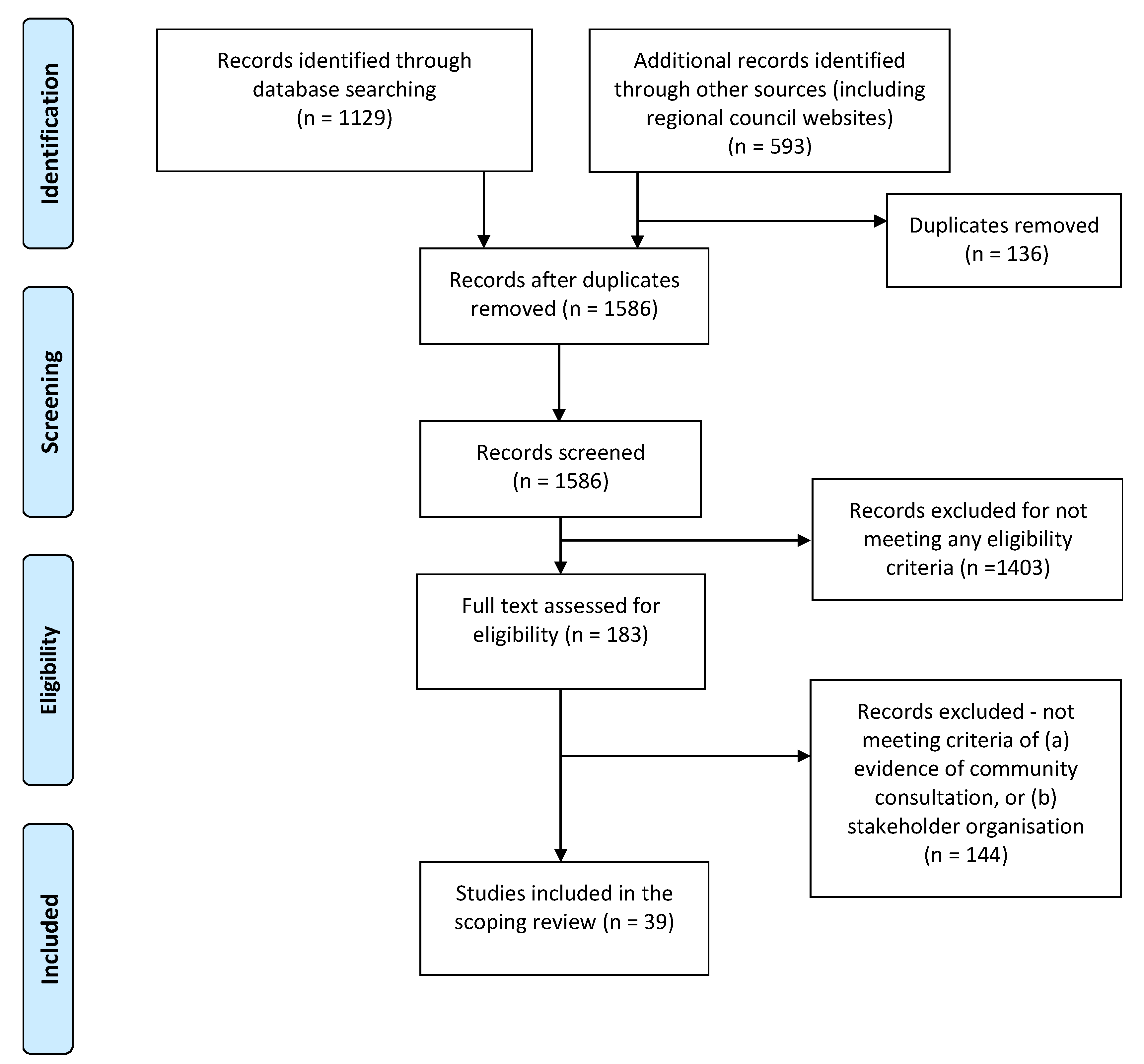
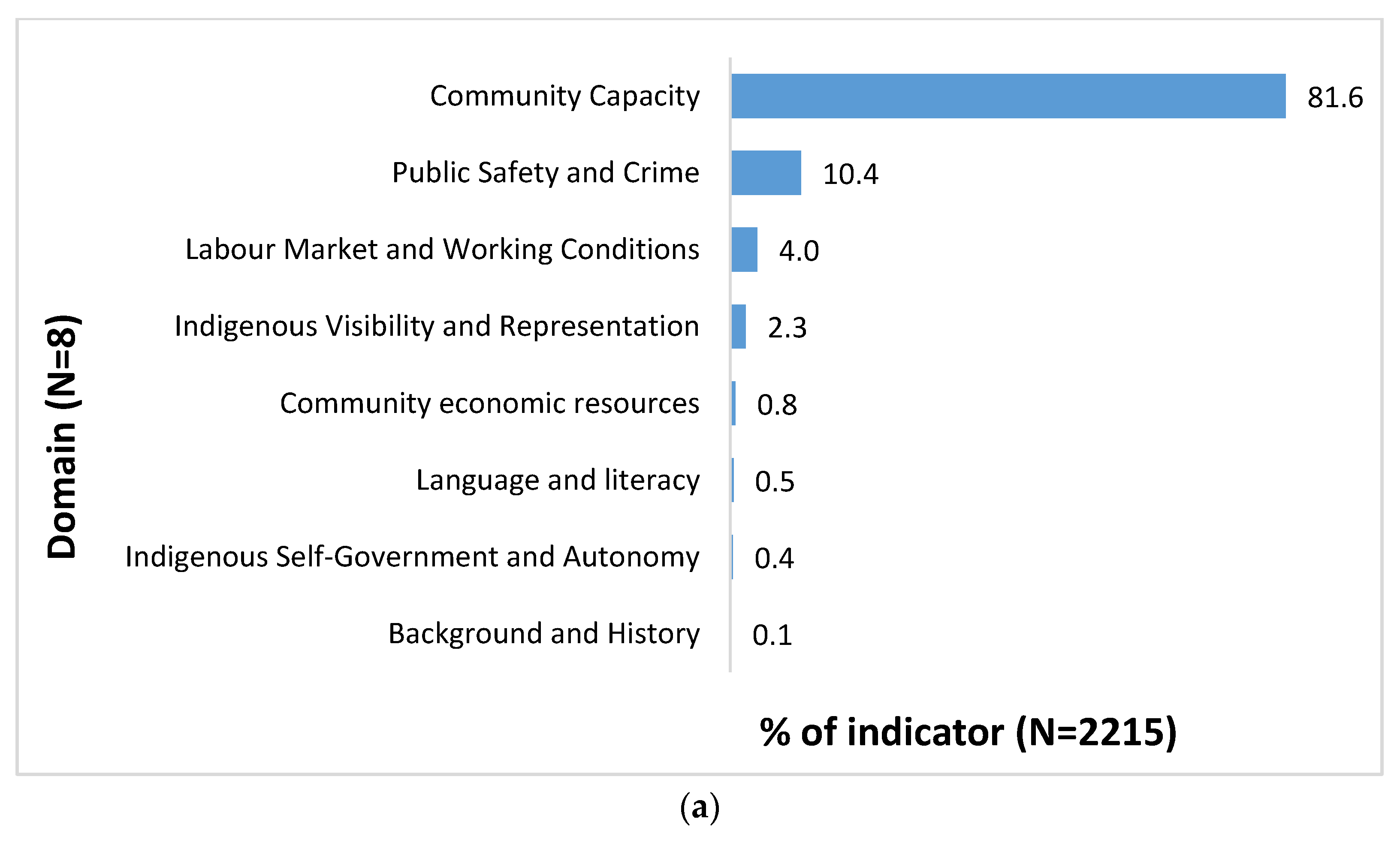
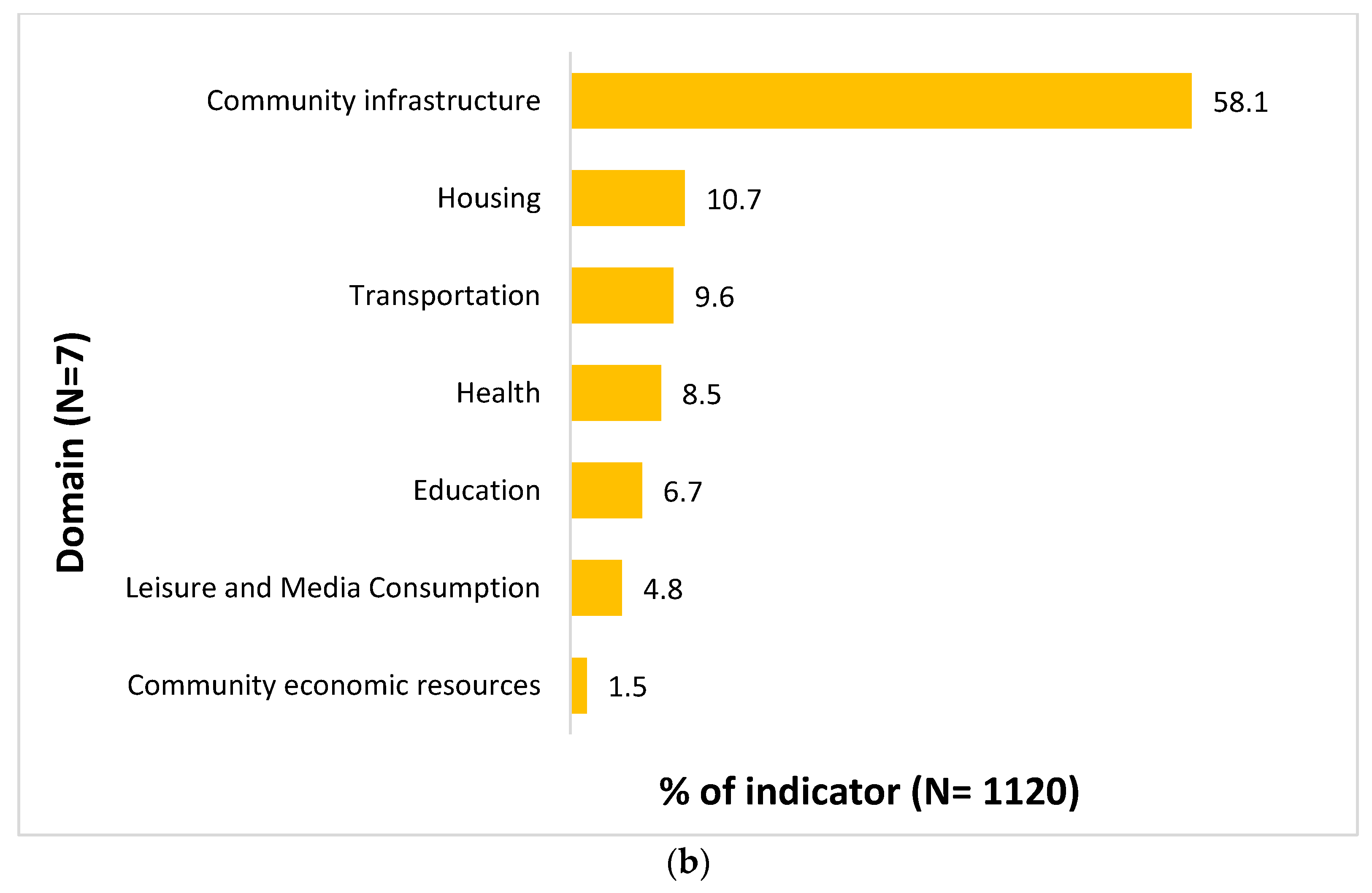
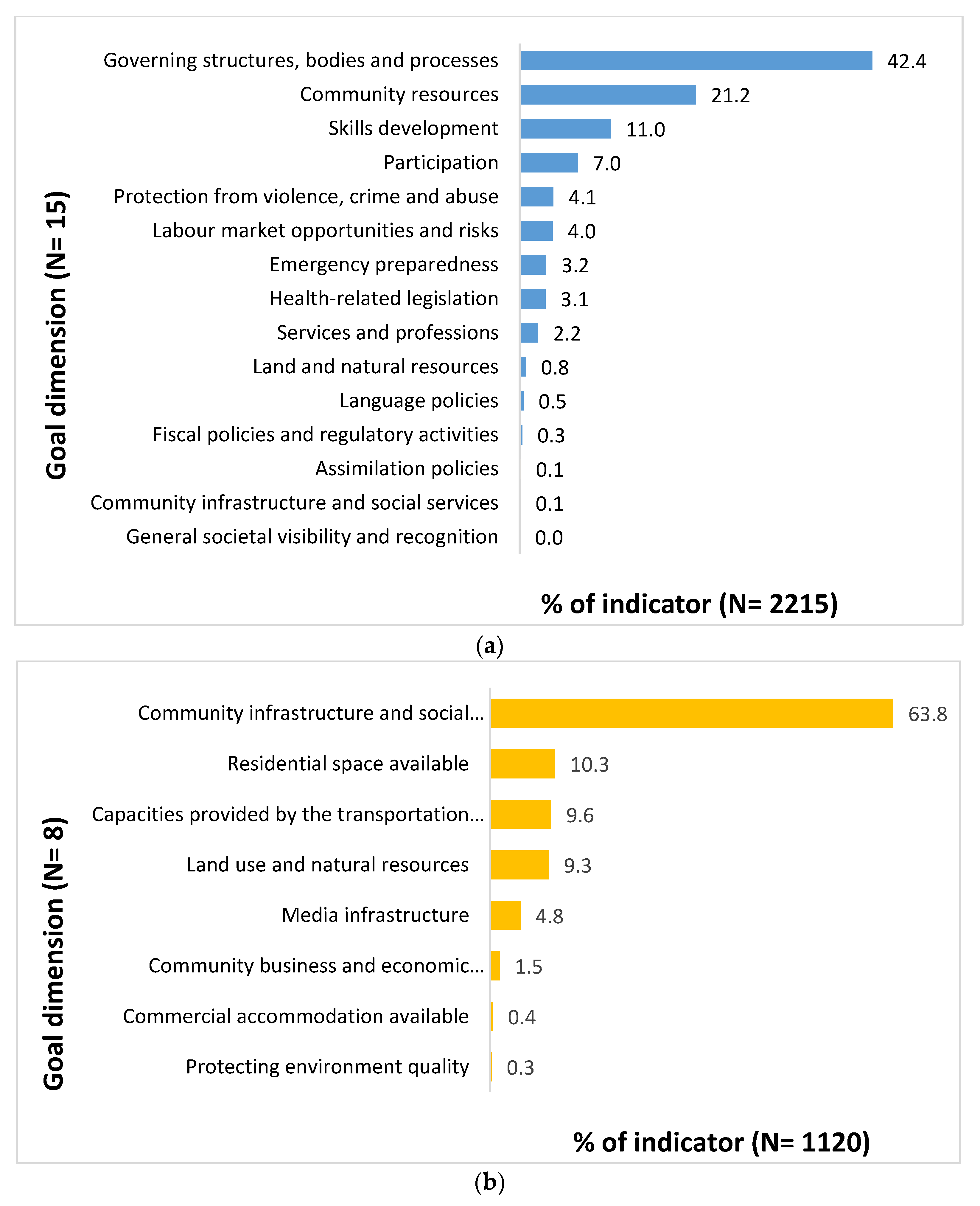
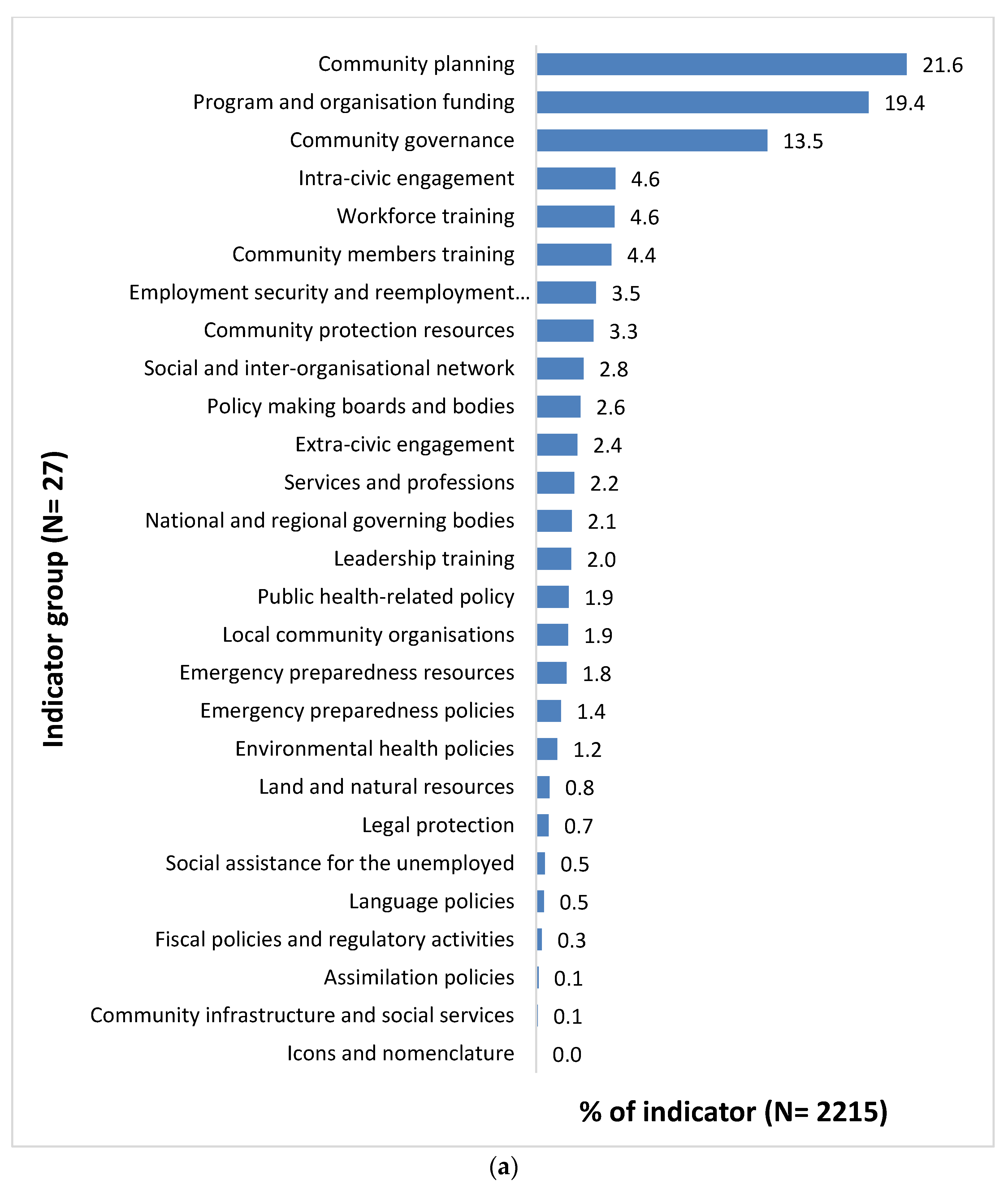
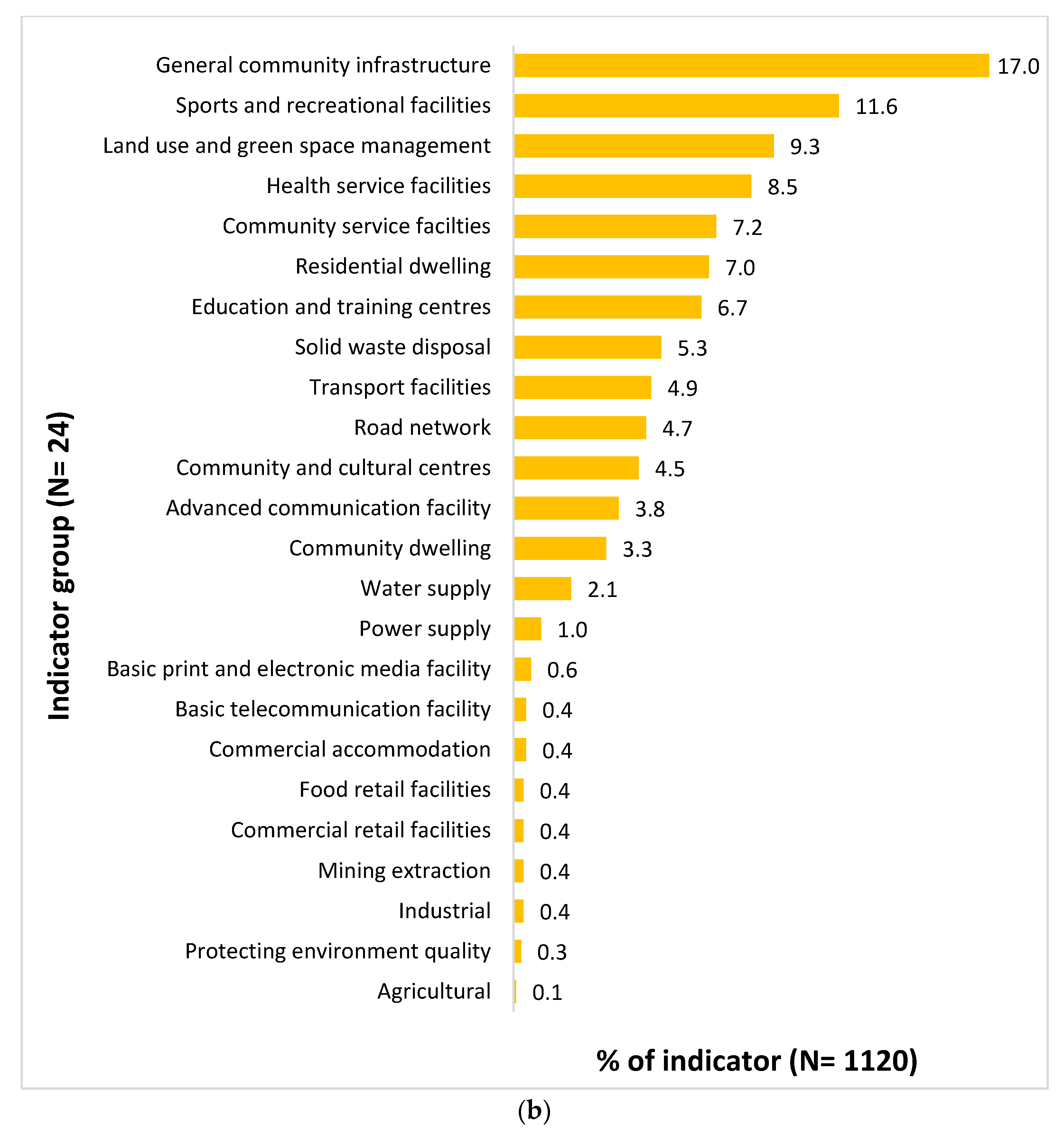
| Criterion No. | Descriptions |
|---|---|
| 1. | Specific to Indigenous people living in one or more remote communities identified for the EnRICH Project in the NT, Australia. |
| 2. | Represent policy, reporting, evaluation, strategic planning, or local planning documents with a focus relevant to health and wellbeing, including preventable chronic disease and/or infectious disease. |
| 3. | Must contain one or more identifiable community-level objective or subjective built and socio-political environmental indicators relevant to the social determinants of health. |
| 4. | Show evidence of consultation (e.g., provide details on who participated, venue, date, and nature of input provided and not merely refer to “the community was consulted”) with Indigenous community members, representatives, or frontline professionals working in the areas of public and environmental health.1 |
| 5. | Publicly available online or in other formats published by government and non-government organizations in the most recent year but not earlier than 2001. |
| 6. | Regional and state or territory level documents were included if they had relevance to one or more communities identified for the EnRICH Project in the NT, Australia. |
| Types of Documents | Descriptive Statistics | No. of Unique Indicator Statements | |
|---|---|---|---|
| Included | Excluded | ||
| Community-level plan (n = 31) | N (number of indicator statements) | 1458 | 276 |
| Mean | 47.0 | 8.9 | |
| SD | 35.1 | 7.3 | |
| Median | 46.0 | 8.0 | |
| 1st Qtl (0.25) | 16.0 | 2.0 | |
| 3rd Qtl (0.75) | 72.5 | 13.0 | |
| Min | 5 | 0 | |
| Max | 120 | 30 | |
| Regional-level plan (n = 8) | N (number of indicator statements) | 455 | 265 |
| Mean | 56.9 | 33.1 | |
| SD | 33.0 | 22.8 | |
| Median | 58.5 | 42.0 | |
| 1st Qtl (0.25) | 32.7 | 11.5 | |
| 3rd Qtl (0.75) | 79.25 | 47.0 | |
| Min | 9 | 3 | |
| Max | 99 | 62 | |
Publisher’s Note: MDPI stays neutral with regard to jurisdictional claims in published maps and institutional affiliations. |
© 2021 by the authors. Licensee MDPI, Basel, Switzerland. This article is an open access article distributed under the terms and conditions of the Creative Commons Attribution (CC BY) license (https://creativecommons.org/licenses/by/4.0/).
Share and Cite
Chakraborty, A.; Daniel, M.; Howard, N.J.; Chong, A.; Slavin, N.; Brown, A.; Cargo, M. Identifying Environmental Determinants Relevant to Health and Wellbeing in Remote Australian Indigenous Communities: A Scoping Review of Grey Literature. Int. J. Environ. Res. Public Health 2021, 18, 4167. https://doi.org/10.3390/ijerph18084167
Chakraborty A, Daniel M, Howard NJ, Chong A, Slavin N, Brown A, Cargo M. Identifying Environmental Determinants Relevant to Health and Wellbeing in Remote Australian Indigenous Communities: A Scoping Review of Grey Literature. International Journal of Environmental Research and Public Health. 2021; 18(8):4167. https://doi.org/10.3390/ijerph18084167
Chicago/Turabian StyleChakraborty, Amal, Mark Daniel, Natasha J. Howard, Alwin Chong, Nicola Slavin, Alex Brown, and Margaret Cargo. 2021. "Identifying Environmental Determinants Relevant to Health and Wellbeing in Remote Australian Indigenous Communities: A Scoping Review of Grey Literature" International Journal of Environmental Research and Public Health 18, no. 8: 4167. https://doi.org/10.3390/ijerph18084167
APA StyleChakraborty, A., Daniel, M., Howard, N. J., Chong, A., Slavin, N., Brown, A., & Cargo, M. (2021). Identifying Environmental Determinants Relevant to Health and Wellbeing in Remote Australian Indigenous Communities: A Scoping Review of Grey Literature. International Journal of Environmental Research and Public Health, 18(8), 4167. https://doi.org/10.3390/ijerph18084167







